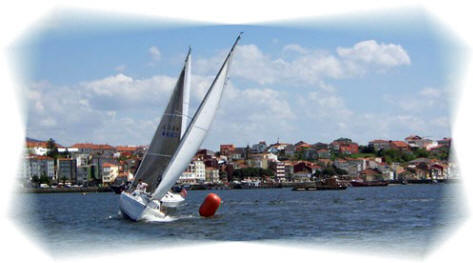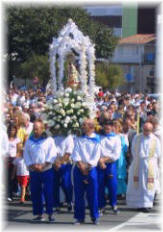|
|
|
 ABOUT RIANXO
ABOUT RIANXO |
The town
|

The town of Rianxo is in the province of La
Coruña (Galicia, Spain), located at the heart of
La Ria de Arousa. It constitutes a transition
zone between the mountain range of Barbanza, the
valley of Quintáns and the estuary of the Ulla
river. Rianxo has a surface of 59 km2, and it
is formed by six parishes: Asados, O Araño,
Isorna, Leiro, Rianxo and Taragoña. Its
population is of approximately 13000 residents.
Rianxo is 45 km far from Santiago de Compostela
and 104 from the region capital La Coruña, being
the C-550 and the dual carriageway of Barbanza
the main communication channels of the council.
The town belongs to the North Arousa region and
in its Eastern limit, the mouth of the Ulla
river, forms the provincial division between the
provinces of La Coruña and Pontevedra.
 |
Cultural
information
|

The cultural life is one of the more important
historical aspects of the town, with an
important number of writers born in the zone,
like Rafael Dieste, Brea Segade, Roxelio Perez,
Manuel Antonio... but it is necessary to make
special mention to Alfonso Daniel Rodriguez
Castelao, who worked as a doctor in the town and
later as a technician of the Geographic and
Statistical Institute, fixing at that moment his
residence in the province of Pontevedra.
Castelao is one of the most illustrious
Galicians, not only as politician, writer and
sketcher, but also as father of the Galician
fatherland.
|
|

The location of Rianxo in La Ria de Arousa
mainly confers important tourist attractiveness
at summer time, with its beaches and a the sea
as main magnets, allowing the benefit of all
type of nautical sports, with good
infrastructures of moorings and services at the
Club Nautical of Rianxo but also without
forgetting the great attractiveness that
provides the landscape thanks to its
conservation and its viewpoints; from A Muralla
mountain, in the parish of Araño, Rianxo and all
La Ría de Arousa, the Barbanza and La Ría de
Muros and Noia, Santiago de Compostela, the Ulla
river and all its surroundings can be seen.
From
the viewpoint of O Castro, in the parish of Taragoña, you can see the valley of Asados and
Taragoña, the inlet of Rianxo, the Barbanza and
La Ría de Arousa; and from the Pena mountain, in
the parish of Leiro, the mouth of the Ulla river
is controlled, partially the inlet of Rianxo but
the town.
Regarding the festivities, in all the parishes
there are patron saint days as the Fiesta de los
Milagros in Araño in August, El Salvador in
Taragoña in July, etc. but if there is one to be
emphasized, it has to be El Carmen in the month
of July, that is celebrated in Taragoña and
Rianxo, as marine zones they are, and, mainly,
the memory of Nuestra Señora de Guadalupe, in
the town capital, the first Sunday of September
after the 8th. One of the more touching moments,
together with the marine procession, is when in
the Patron Saint Day of the Virgin, twelve at
night, all the orchestras concentrated in the
town central square start singing A Rianxeira
one after another, uninterruptedly, while all
people there congregated carry flares and
candles.
|
What to see
|

With regard to the religious architecture, it is
necessary to emphasize the parish church of Santa
Columba de Rianxo, built in the 15th century,
but with different architectonic styles progressively
added like gothic, plateresco and baroque.
The chapel of Nuestra Señora de Guadalupe was risen in
the 17th century upon the older called
Nuestra Señora de la Cruz, and from the first half of
the 19th century it welcomes the image of La
Virgen de Guadalupe, whose statue was sculpted in 1773
by Fray Jose of Santiago, sculptor from Rianxo. To her
is dedicated the most popular of the Galician songs: La
Rianxeira.
Regarding the civil architecture Rianxo counts with a
good number of pazos (palaces), although the
conservation condition is different according to the
cases, being in a better condition the one of Martelo in
the town of Rianxo, where the public library is located
at present; the one of Viturro in Rianxiño and two
belonging to the family of Los Torrado, located in
Asados and Brión-Leiro.
Also it is
worthy to point out
some Hórreos, especially the one in Araño, in Traba
place that is one of the longest of Galicia.
Viturro in Rianxiño and two
belonging to the family of Los Torrado, located in
Asados and Brión-Leiro.
Also it is
worthy to point out
some Hórreos, especially the one in Araño, in Traba
place that is one of the longest of Galicia.
Among the sculpture art there are several "Cruceiros",
like the one of A Capeliña de Laxe Pequena in Taragoña,
of the 16th century, and the one of Outeiro
de Asados, 17th century.
And do not forget the beaches: The beach of Tanxil has
been awarded in 2005 with the Blue Flag of the European
Union.
For more information on what to see in Rianxo visit the
Web of the City council:
|
|
|
|